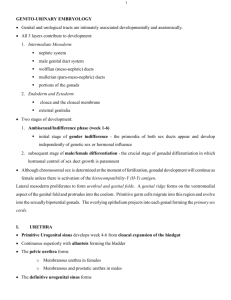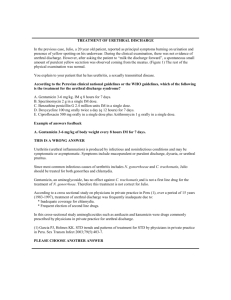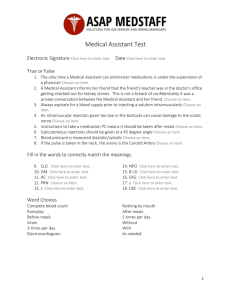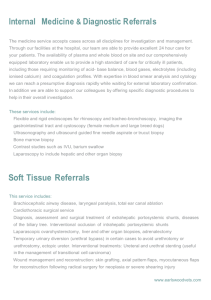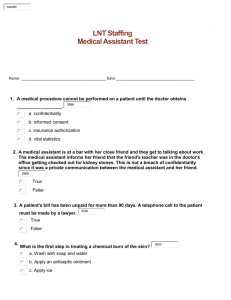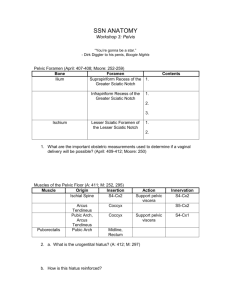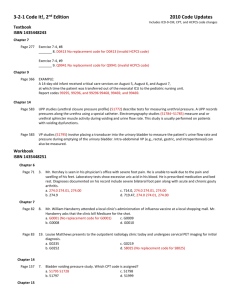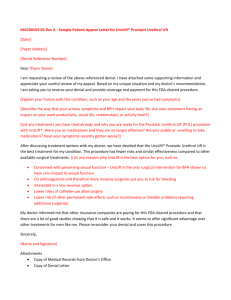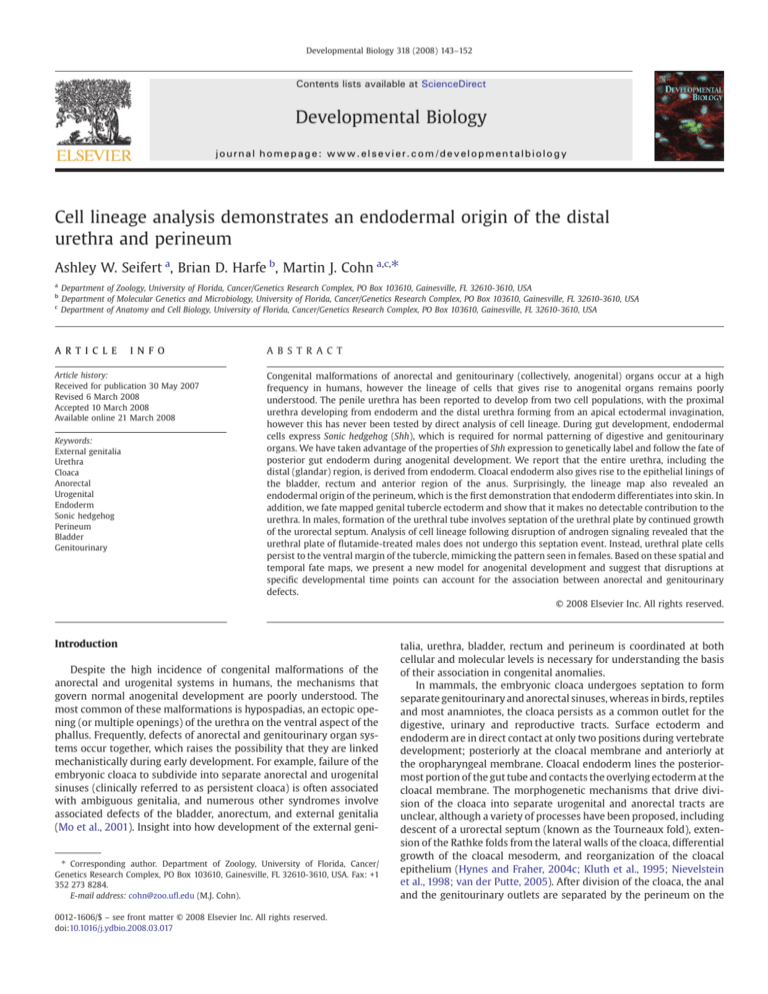
Developmental Biology 318 (2008) 143–152
Contents lists available at ScienceDirect
Developmental Biology
j o u r n a l h o m e p a g e : w w w. e l s e v i e r. c o m / d e v e l o p m e n t a l b i o l o g y
Cell lineage analysis demonstrates an endodermal origin of the distal
urethra and perineum
Ashley W. Seifert a, Brian D. Harfe b, Martin J. Cohn a,c,⁎
a
b
c
Department of Zoology, University of Florida, Cancer/Genetics Research Complex, PO Box 103610, Gainesville, FL 32610-3610, USA
Department of Molecular Genetics and Microbiology, University of Florida, Cancer/Genetics Research Complex, PO Box 103610, Gainesville, FL 32610-3610, USA
Department of Anatomy and Cell Biology, University of Florida, Cancer/Genetics Research Complex, PO Box 103610, Gainesville, FL 32610-3610, USA
A R T I C L E
I N F O
Article history:
Received for publication 30 May 2007
Revised 6 March 2008
Accepted 10 March 2008
Available online 21 March 2008
Keywords:
External genitalia
Urethra
Cloaca
Anorectal
Urogenital
Endoderm
Sonic hedgehog
Perineum
Bladder
Genitourinary
A B S T R A C T
Congenital malformations of anorectal and genitourinary (collectively, anogenital) organs occur at a high
frequency in humans, however the lineage of cells that gives rise to anogenital organs remains poorly
understood. The penile urethra has been reported to develop from two cell populations, with the proximal
urethra developing from endoderm and the distal urethra forming from an apical ectodermal invagination,
however this has never been tested by direct analysis of cell lineage. During gut development, endodermal
cells express Sonic hedgehog (Shh), which is required for normal patterning of digestive and genitourinary
organs. We have taken advantage of the properties of Shh expression to genetically label and follow the fate of
posterior gut endoderm during anogenital development. We report that the entire urethra, including the
distal (glandar) region, is derived from endoderm. Cloacal endoderm also gives rise to the epithelial linings of
the bladder, rectum and anterior region of the anus. Surprisingly, the lineage map also revealed an
endodermal origin of the perineum, which is the first demonstration that endoderm differentiates into skin. In
addition, we fate mapped genital tubercle ectoderm and show that it makes no detectable contribution to the
urethra. In males, formation of the urethral tube involves septation of the urethral plate by continued growth
of the urorectal septum. Analysis of cell lineage following disruption of androgen signaling revealed that the
urethral plate of flutamide-treated males does not undergo this septation event. Instead, urethral plate cells
persist to the ventral margin of the tubercle, mimicking the pattern seen in females. Based on these spatial and
temporal fate maps, we present a new model for anogenital development and suggest that disruptions at
specific developmental time points can account for the association between anorectal and genitourinary
defects.
© 2008 Elsevier Inc. All rights reserved.
Introduction
Despite the high incidence of congenital malformations of the
anorectal and urogenital systems in humans, the mechanisms that
govern normal anogenital development are poorly understood. The
most common of these malformations is hypospadias, an ectopic opening (or multiple openings) of the urethra on the ventral aspect of the
phallus. Frequently, defects of anorectal and genitourinary organ systems occur together, which raises the possibility that they are linked
mechanistically during early development. For example, failure of the
embryonic cloaca to subdivide into separate anorectal and urogenital
sinuses (clinically referred to as persistent cloaca) is often associated
with ambiguous genitalia, and numerous other syndromes involve
associated defects of the bladder, anorectum, and external genitalia
(Mo et al., 2001). Insight into how development of the external geni-
⁎ Corresponding author. Department of Zoology, University of Florida, Cancer/
Genetics Research Complex, PO Box 103610, Gainesville, FL 32610-3610, USA. Fax: +1
352 273 8284.
E-mail address: cohn@zoo.ufl.edu (M.J. Cohn).
0012-1606/$ – see front matter © 2008 Elsevier Inc. All rights reserved.
doi:10.1016/j.ydbio.2008.03.017
talia, urethra, bladder, rectum and perineum is coordinated at both
cellular and molecular levels is necessary for understanding the basis
of their association in congenital anomalies.
In mammals, the embryonic cloaca undergoes septation to form
separate genitourinary and anorectal sinuses, whereas in birds, reptiles
and most anamniotes, the cloaca persists as a common outlet for the
digestive, urinary and reproductive tracts. Surface ectoderm and
endoderm are in direct contact at only two positions during vertebrate
development; posteriorly at the cloacal membrane and anteriorly at
the oropharyngeal membrane. Cloacal endoderm lines the posteriormost portion of the gut tube and contacts the overlying ectoderm at the
cloacal membrane. The morphogenetic mechanisms that drive division of the cloaca into separate urogenital and anorectal tracts are
unclear, although a variety of processes have been proposed, including
descent of a urorectal septum (known as the Tourneaux fold), extension of the Rathke folds from the lateral walls of the cloaca, differential
growth of the cloacal mesoderm, and reorganization of the cloacal
epithelium (Hynes and Fraher, 2004c; Kluth et al., 1995; Nievelstein
et al., 1998; van der Putte, 2005). After division of the cloaca, the anal
and the genitourinary outlets are separated by the perineum on the
144
A.W. Seifert et al. / Developmental Biology 318 (2008) 143–152
posterior surface of the embryo. Since the middle of the 19th century, it
has been reported that the perineum forms by medial growth and
fusion of the cloacal folds, in a manner similar to fusion of the palatal
shelves (Larson, 2001; Nievelstein et al., 1998). Recent work in humans
and in mice has challenged this interpretation, suggesting instead that
the perineum is derived from the urorectal septum (Dravis et al., 2004;
Hynes and Fraher, 2004c; Sasaki et al., 2004; van der Putte, 2005).
Identifying the developmental origin of the perineum should clarify
how the posterior-most part of the embryonic gut gives rise to anorectal and genitourinary organs.
In both male and female mammalian embryos, development of the
external genitalia begins with the emergence of the paired genital
swellings immediately above the cloaca (see Perriton et al., 2002 for a
detailed description of normal external genitalia development in
mouse). These swellings fuse medially and give rise to the bipotential
genital tubercle, which can be masculinized to form the penis or feminized to form the clitoris. As the genital tubercle grows out, the ventral
side of the cloacal endoderm forms a bilaminar urethral plate that
extends into the genital tubercle, and this structure later cavitates in a
proximal to distal direction to form the urethral tube (Hynes and
Fraher, 2004a; Perriton et al., 2002). Classical accounts of external
genital development reported that the urethra has a dual embryonic
origin – with the distal (glandar) portion arising from an ectodermal
invagination from the distal tip of the genital tubercle and the proximal
portion coming from the endodermal urethral plate – a description
that remains in contemporary embryology textbooks (Glenister, 1954;
Larson, 2001; Moore, 2007; Sadler, 2006). An alternative model proposes that the entire urethra forms from endoderm, which undergoes
differentiation in the glandar portion to form squamous epithelium
(Felix, 1912; Kurzrock et al., 1999; Penington and Hutson, 2002a,b;
Perriton et al., 2002), however neither model has been tested by direct
analysis of cell lineage.
During sexual differentiation of the external genitalia in mice,
which occurs under the control of androgens, the bilaminar urethral
plate is transformed into a central urethral tube along the length of the
penis (Baskin et al., 2001; Hynes and Fraher, 2004b; Mahendroo et al.,
2001; Yamada et al., 2003). Prior to masculinization, the urethral plate
extends from the center of the genital tubercle to its ventral edge,
where it contacts the surface ectoderm at the cloacal membrane. The
dorsal aspect of the urethral plate is thought to become the definitive
urethral tube, while the ventral portion is remodeled such that the
urethral tube becomes surrounded by stromal mesenchyme. It is
unknown whether removal of the ventral aspect of the urethral plate is
accomplished by apoptosis, an epithelial-to-mesenchymal transition
or through morphogenetic movement of the urethral epithelium. By
contrast, female genital development involves little remodeling of the
urethral plate, resulting in a more proximal and ventral urethral
opening. While apoptosis has been reported to occur in this region, the
possibility of an epithelial-to-mesenchymal transition has not been
excluded. Resolution of the cellular origin of the urethra and the fate of
ventral urethral plate cells is important for identifying the cell population(s) affected in hypospadias and for investigations of gene function during urethragenesis.
Sonic hedgehog (Shh) is expressed throughout the endodermal epithelium of the gut, where it persists during division of the cloaca and
formation of the urethral plate (Bitgood and McMahon, 1995; Echelard
et al., 1993; Haraguchi et al., 2001; Perriton et al., 2002). Shh−/− mice fail
to form a genital tubercle, indicating that Shh is required for development of the external genitalia (Haraguchi et al., 2001; Perriton et al.,
2002). In addition, loss of Shh function results in a failure of cloacal
septation, and mice are born with a persistent cloaca. The finding that
Shh−/− mutants have severe defects of their genital and cloacal derivatives suggests that early Shh signaling from the hindgut endoderm
may act to coordinate morphogenesis of the entire anogenital system.
Here we investigate the cellular origins of the distal urethra and the
perineum, and test the hypothesis that the ventral aspect of the
urethral plate is removed during urethragenesis by an epithelial-tomesenchymal transition. We exploited the fact that endodermal cells
of these organ systems express Shh during early development, in order
to genetically label and fate map the cloacal endoderm during anorectal and genitourinary organogenesis. Our lineage analysis provides
the first direct evidence that the entire urethra is derived from endoderm, and that the transformation of the solid urethral plate into the
definitive male urethra occurs in the absence of an epithelial-tomesenchymal transition. The epithelial linings of the bladder, rectum
and anterior region of the anus also are derived from Shh-expressing
endoderm. Moreover, we present the unexpected finding that cloacal
endoderm gives rise to the perineum, which is the first demonstration that endoderm differentiates into skin. We also fate mapped the
ectoderm of the genital tubercle and show that it does not contribute
to the urethral tube. Finally, we followed Shh descendant cells after
disruption of androgen signaling and show that feminization of the
male genitalia results from persistence of the endodermal urethral
plate along the ventral margin of the genital tubercle. Taken together,
these results reveal the fate of the cloacal endoderm during anorectal
and urogenital organogenesis, and highlight the importance of this
cell population in the coordinated formation of the anogenital
system.
Materials and methods
Transgenic mice and lineage analysis
The ShhGFPcre, Msx2cre, and Rosa26 reporter (R26R) mice used in this study have
been described previously (Harfe et al., 2004; Soriano, 1999; Sun et al., 2000). The
ShhGFPcre allele was generated by knocking a GFPcre fusion cassette into the start site
of the Shh locus, placing cre-recombinase under the control of the endogenous Shh
promoter (Harfe et al., 2004). The ShhGFPcre allele is a null allele, however heterozygous
animals are phenotypically normal and breed successfully (Harfe et al., 2004). In
Msx2cre mice, cre recombinase is driven by the proximal Msx2 promoter (Liu et al., 1994;
Sun et al., 2000). To irreversibly label ShhGFPcre- or Msx2cre-expressing cells, we
crossed heterozygous males to females carrying the R26R reporter allele. Females were
inspected for vaginal plugs and the morning they were found was determined as
embryonic day (E)0.5. Pregnant dams were sacrificed at specific time points to collect a
staged series of embryos with either ShhGFPcre;R26R or Msx2cre;R26R genotypes. The
genitalia and limbs were used to confirm age, and embryos were processed for X-gal
staining and histological analysis.
Flutamide administration
Suspensions of flutamide (Sigma F9397) were prepared daily in corn oil. The corn oil
was filtered and heated at ∼ 55 °C to dissolve the flutamide. Flutamide was administered
in 200 μl S.C. injections at 100 mg/kg/day. Injections began on E13.5 and continued until
pups were born. Injection sites were altered each day between shoulder and haunch.
Control females were injected daily with the vehicle alone in the same manner.
X-gal staining
β-Galactosidase activity was detected using X-gal. Embryos were harvested in PBS
and fixed overnight in 0.2% PFA at 4 °C. Embryos were washed three times in LacZ rinse
buffer (1 M sodium phosphate pH 7.4, 0.1% sodium deoxycholate, 1 M MgCl2, 0.02%
NP40), then stained with X-gal overnight rocking at room temperature. Embryos were
then rinsed, post-fixed and stored in 4% PFA at 4 °C.
Histology
X-gal stained embryos were processed into either paraffin wax or OCT for
histological analysis. For wax prepared specimens, samples were dehydrated in a
graded ethanol series, taken through a xylene substitute (XS-3, Statlab) to preserve the
β-galactosidase, and embedded in paraffin. Samples were cut at 10 μm thickness and
counterstained with Biebrich Scarlet. For cryosectioning, embryos were taken through a
graded series of 15% sucrose/PBS, 30% sucrose/PBS, and 30% sucrose/50% OCT before
being embedded in 100% OCT and cut in 10 μm serial sections.
Results
Cloacal endoderm gives rise to the entire urethral epithelium
In order to resolve the origin of the glandar urethra, we first sought
to determine the cellular origin of the entire urethral plate. It has been
A.W. Seifert et al. / Developmental Biology 318 (2008) 143–152
shown previously that Shh is expressed in the developing gut endoderm and is excluded from the surrounding mesoderm and ectoderm
during development of the urogenital system (Bitgood and McMahon,
1995; Haraguchi et al., 2001; Perriton et al., 2002). Therefore, in order
to fate map the entire cloacal endoderm, we utilized the ShhGFPcre
allele to irreversibly activate the Rosa26 reporter (R26R) allele in all
Shh-expressing cells and their descendants.
Prior to initiation of genital tubercle outgrowth at E10.5, all cloacal
endoderm expresses Shh, and R26R activity confirmed that ShhGFPcre
expression faithfully follows the endogenous Shh expression pattern
(Fig. 1A). Histological sections through the cloacae of ShhGFPcre;R26R
mice at E10.5 showed that labeled cloacal endoderm cells are in
contact with surface ectoderm, and the junction of these two cell layers
comprises the cloacal membrane (Fig. 1B). The caudal-most junction of
these two cell layers, at the base of the tail, occurs at the proctodeum,
the future site of the anal opening (Fig. 1C, white asterisk). Between
E10.5 and E11.5, the lateral walls of the LacZ-labeled cloacal epithelium
come into apposition at the distal tip of the tubercle to form the beginning of a bilaminar urethral plate (Fig. 1D). This apposition continues proximally as the tubercle grows out (Figs. 1D, F). The junction
between urethral plate endoderm and surface ectoderm is maintained,
and mesoderm lateral to the cloacal membrane does not invade this
morphological boundary (Fig. 1F). As the genital tubercle grows out,
expansion of the anterior mesodermal population on the dorsal aspect
of the tubercle (visible as a dorsal swelling) results in ventral displacement of the urethral plate (Figs. 1C, E, G; see also Perriton et al., 2002).
The urethral plate consisted of ShhGFPcre descendant cells at E13.5,
145
and analysis of labeled cells during urethral tube formation indicated
that this endodermal population gives rise to the entire urethral tube,
including the glandar portion (Fig. 2).
Cloacal endoderm gives rise to the perineum
Activation of reporter gene expression in cloacal endoderm also
allowed us to map morphogenesis of the urorectal septum, a population of mesoderm that divides the cloaca into the anorectal and
urogenital sinuses. By E10.5, the leading edge of the urorectal septum
extended into the labeled endoderm at the anterior side of the cloaca
(Fig. 1A). Beginning at E11, we observed a caudal expansion of the
peritoneal cavity into the urorectal septum mesoderm (Fig. 1C). The
urorectal septum mesoderm continues partitioning the cloaca into
the urogenital sinus and the hindgut between stages E11.0 and E13.5
(Figs. 1C, E, G).
At the cloacal membrane, LacZ-labeled endoderm is in contact with
surface ectoderm, and the strict boundary maintained between LacZpositive and -negative cells suggests that these cell populations do not
intermix (Figs. 1B, D, F). Endoderm and ectoderm abut one another
along the ventral side of the genital tubercle and at the proctodeum
until the cloacal membrane ruptures at ∼ E13.0, creating the anus and
resulting in transient exposure of the urethra at the base of the tubercle
(Figs. 1G, H). As the cloacal membrane ruptures, ectoderm degenerates
between the anus and the base of the genital tubercle and is replaced
by LacZ-labeled endodermal cells at leading edge of the urorectal
septum (Fig. 1H). As a result, endodermal cells at the caudal end of the
Fig. 1. ShhGFPcre-expressing endodermal cells give rise to the epithelium of the urethral plate, perineum, bladder and anorectum. ShhGFPcre;R26R mouse embryos stained with XGal to reveal LacZ-positive cells (labeled blue). Panels A, C, E and G are lateral views of genital region with the right hindlimb bud removed. Panels B, D and F are sections along the
proximodistal axis of the genital tubercle, cut transverse to the trunk. (H) Ventral view of the genital tubercle. Stages shown in upper right corners. Schematic diagrams across the
bottom refer to stages shown in panels A, C, E, and G; dotted lines indicate planes of section shown in panels B, D, and F (red, ectoderm; blue, endoderm, gray; mesoderm). (A)
Urorectal septum mesoderm has begun to septate the cloaca. (B) Labeled cloacal endoderm lies in contact with the unlabeled surface ectoderm to form the cloacal membrane. (C)
Distribution of labeled endodermal cells in urogenital sinus (ugs), hindgut (hg), cloaca (cl), tailgut (tg). Urorectal septum mesoderm (urs) has extended into the anterior region of the
cloaca. Note position of anterior genital mesoderm (agm) relative to urogenital sinus. Asterisk marks the position of the proctodeum. (D) Labeled cloacal endoderm is beginning to
form a bilaminar urethral plate (UP), which extends to distal tip of the genital tubercle where it abuts surface ectoderm (ecto). (E, F) Urethral plate (UP) spans the proximodistal
length of the genital tubercle. The URS is approaching the proctodeum (asterisk). (G, H) Surface ectoderm at the base of the tail has ruptured and labeled endodermal cells have
formed the central margin of the perineum (per).
146
A.W. Seifert et al. / Developmental Biology 318 (2008) 143–152
Fig. 2. Sexual differentiation of the urethral plate. Urethral tube development in male (A, C, E, G) and female (B, D, F, H) ShhGFPcre;R26R mice between E15.5 and birth (P0). ShhGFPcreexpressing cells and their descendants are stained blue. Ventral/Posterior surface of the genital tubercle is to the right in panels A–F and to the bottom in panels G and H. The tail is
removed. (A, B) LacZ-labeled cells extend to the distal-most tip of the urethral plate (up; arrowheads) in the glans. The urethral duct (ud) is open in both males and females. Labeled
cells are visible along the surface of the perineum (per; arrows). Dashed lines mark the position of the proximal urethra (u). Preputial folds (pf) and preputial glands are visible in
panels A–D. (C) Male at E17.5, in which mesoderm of the urorectal septum (urs) and prepuce is seen invading the proximal end of the urethral plate (dashed line and asterisk). (D)
Female at E17.5 showing the unseptated urethral plate (asterisk). (E) In neonatal males, the urethral duct has closed (compare with panels A and F) and endodermal cells along the
surface of the perineum are contiguous with the ventral urethral seam. (F) In neonatal females, the urethral duct, which contains LacZ-positive cells, remains open and forms the
posterior portion of the vagina. (G, H) The distal urethra in both males and females is derived from ShhGFPcre-expressing cells. The female urethral opening lies more proximal and
ventral than the male urethra, which is positioned just beneath the apex of the glans.
A.W. Seifert et al. / Developmental Biology 318 (2008) 143–152
urorectal septum come to lie on the surface of the embryo, where they
form the central margin of the perineum (Figs. 1H, 2A, B).
Sexual differentiation of the urethra
We next investigated the mechanism by which the male forms a
tubular urethra within the glans penis, whereas in females, an epithelial cord persists ventrally in the clitoris. At E15.5, the male and
female genital tubercles are still morphologically similar, although the
anogenital distance (the perineal area between the urogenital duct and
the anus) is shorter in females (Figs. 2A, B). At E15.5, LacZ-labeled
endodermal cells that previously covered the urorectal septum are
visible along the central seam of the perineum (Figs. 2A, B). Beneath
the perineum, mesoderm of the scrotal swellings in the male and labial
swellings in the female is continuous with the mesoderm of the urorectal septum and with the proximal portion of the emerging preputial swellings (Figs. 2A, B). Thus, three distinct outgrowths (labioscrotal
swellings, preputial swellings and urorectal septum) arise from a
147
continuous population of cloacal mesoderm. The prepuce then envelops the glans from proximal to distal (Figs. 2A–F). At E15.5, the
urethra extends to the distal tip of the genital tubercle and is composed
entirely of cells descended from ShhGFPcre-expressing endoderm
(Figs. 2A, B and 3E, F).
The proximal portion of the urethral plate has cavitated by E15.5
to form the proximal urethral tube in both males and females (Figs.
3A, B). The urethral duct is open at the proximal end of the phallus in
both sexes. Within the distal portion of the glans, which is not yet
surrounded by the prepuce, the urethral plate remains in contact
with the overlying ectoderm (Figs. 3E, F). Preputial glands begin to
develop in both sexes at E13.5, when focal spots of ShhGFPcreexpressing ectoderm begin to invaginate into preputial mesenchyme
(Figs. 2A, B).
Beginning at E15.5, the distribution of ShhGFPcre descendants
reveals the onset of sexual differentiation of the urethra (Figs. 2C, D and
3A–F). In males, the urethral plate is septated from proximal to distal to
create the definitive urethral tube within the glans, whereas in females
Fig. 3. Transformation of the urethral plate to a urethral tube. Comparison of urethral tube development in male (A, C, E, G, I, K) and female (B, D, F, H, J, L) ShhGFPcre;R26R mice at
E15.5 and E17.5. Ventral is at the bottom. Cells derived from the ShhGFPcre-expressing population are stained blue. Sections are transverse to the genital tubercle at proximal, middle
and distal levels (shown in schematic diagrams above each column). (A–F) Labeled cells are restricted to the urethral plate epithelium and are absent from the mesenchyme at E15.5.
Cavitation of the urethral plate proceeds from proximal to distal and the urethral duct (ud) is open in both males and females (u, urethra). (G) Male urethral plate is septated by
urorectal septum mesoderm at the proximal end. Note the remnant of the urethral plate at the ventral edge of the penis. (H) The female urethral plate remains unseptated and the
proximal urethral duct remains open to form the posterior portion of the vagina (v). (I, K) Mesoderm has not yet invaded the middle (I) or distal (K) portions of the male urethral plate,
which extends to the ventral edge of the penis. (J, L) Female urethral plate is tubular at the mid-shaft (J), but persists as a cord distally (L). Note the absence of mesoderm ventral to
urethral plate in the female (arrow in panel L).
148
A.W. Seifert et al. / Developmental Biology 318 (2008) 143–152
this septation fails to occur (Figs. 2C, D). By E17.5, the male urethral
plate has been divided into a central urethral tube and a ventral seam
(Fig. 3G), whereas the female urethral plate persists to the ventral edge
of the clitoris (Fig. 3H). The distribution of ShhGFPcre descendant cells
in males shows that septation occurs when mesoderm of the preputial
swellings and urorectal septum converges ventral to the definitive
urethra (Fig. 3G). During urethral septation, the preputial swellings
continue to envelop the glans (Figs. 2C, E). As a result of these coordinated movements, the urethral plate is divided dorsoventrally, with
the dorsal portion forming the definitive urethra and the ventral portion forming the urethral seam along the ventral edge of the penis (Fig.
3G). The absence of LacZ-labeled cells from the genital mesenchyme
indicates that the urethral epithelium does not undergo a transition to
mesenchyme during septation (Figs. 3G, I).
In females, proximal mesoderm fails to invade the genital tubercle
and, consequently, the urethral plate is not septated (compare Fig. 2C
with D, Fig. 3G with H, and I with J). As in males, the female preputial
swellings continue to grow distally and both the cloacal and preputial
folds expand medially to envelop the glans clitoris (Figs. 2D, F and 3H, J,
L). At the same time, the proximal urethral plate is cavitated centrally to
form the female urethra (Fig. 3J). This results in the female urethra
remaining ventral to the glans, in contrast to the male condition, in
which the urethral tube lies within the glans at E17.5 (Fig. 3 compare I
and J). The urethral duct remains open and will form the posterior
portion of the vagina, which we also found to be derived from
ShhGFPcre-expressing endoderm (Fig. 3H). In the distal region of the
clitoris, the labeled urethral plate cells form an epithelial cord, whereas
in males the plate continues to cavitate distally to form the penile
urethra (Figs. 3K, L). At birth, the female urethra lies distal to the vaginal
opening, and is also derived entirely from endoderm (Figs. 2F, H).
In neonatal (P0) males, the glandar urethra is composed of
ShhGFPcre descendants, indicating its endodermal origin (Figs. 2E, G).
The distal glans is enveloped by the prepuce, and the penile urethra is
positioned centrally within the glans (Fig. 2E). Endodermally derived
cells are still visible at the apical opening of the urethra, along the
ventral seam of the preputial folds, and on the exterior surface of the
perineum (Figs. 2E, G). The proximal urethral duct in the male has
closed, and labeled cells were restricted to the definitive urethral tube,
including the distal meatus, and to the remnant of the ventral preputial
seam (Figs. 2E, G).
There is no ectodermal contribution to the glandar urethra
The fate map of ShhGFPcre-expressing cells and their descendants
showed an unequivocal contribution of endoderm to the glandar
urethra, however these experiments could not exclude the possibility
that some ectodermal cells are incorporated into the distal region.
Therefore, we investigated whether the glandar urethra has an
ectodermal component by using another cre allele to activate reporter
gene expression in the genital ectoderm. We found previously that
Msx2 is expressed in the ectoderm overlying the developing genital
tubercle at E11.5, and it remains restricted to the dorsal and distal
ectoderm of the genital tubercle at later developmental stages (Fig. 4A
inset). We first determined whether the Msx2cre allele (Sun et al.,
2000) is expressed in distal genital tubercle ectoderm by crossing
Msx2Cre males to females carrying R26R, and then examining reporter
gene expression in embryos at E12.5. We found that Msx2cre activated
lacZ in ectoderm of the developing genital tubercle in a domain that
was broader than endogenous Msx2 expression, and included the
dorsal, distal and ventral medial ectoderm, but excluded the endoderm
and mesoderm (Fig. 4A). Having determined this cre line to be an
efficient marker of the genital tubercle ectoderm, we then examined
the distribution of Msx2cre descendants in P0 males. Msx2cre-expressing cells and their descendants were distributed throughout the surface ectoderm of the penis, however labeled cells were notably absent
from the urethral opening, the seam of preputial fold fusion, and the
midline of the perineum (Fig. 4B). Histological analyses confirmed that
blue cells were restricted to the ectoderm and did not invaginate into
the glandar urethra (Fig. 4C). Transverse sections showed a sharp
boundary between the ectodermally derived Msx2cre-expressing cells
and the urethral tube (Fig. 4C). Taken together, these findings show
that the glandar urethra is derived entirely from endoderm and that
ectoderm makes no detectable contribution.
Disruption of androgen signaling feminizes male genitalia without
affecting urethral epithelial integrity
Disruption of androgen signaling during mammalian external genital development causes feminization of the male genitalia and can
result in hypospadias. Having identified the cellular basis of masculinization and feminization of the urethra, we next investigated whether
antagonism of androgen receptor (AR) activity, using the AR antagonist
flutamide, altered the behavior of the male urethral cell lineage.
Administration of flutamide (100 mg/kg/day) to pregnant dams from
E13.5 resulted in complete feminization of the external genitalia and
urethras of male pups (Figs. 5A–D). Analysis of ShhGFPcre descendant
cells in flutamide-treated males revealed that the urethral plate did not
undergo septation by the mesoderm, a process that occurred normally
in control males treated with corn oil (Fig. 5, compare A, A′ with C, C′).
Consequently, the urethral endoderm of flutamide-treated males failed
to form a centralized urethral tube. The distribution of ShhGFPcre descendant cells in flutamide-treated mice showed that the urethral plate
persisted from the midline of the phallus to the ventral margin, indicating that feminization of the male urethral plate by AR antagonism
mimics the process that occurs in normal female development (i.e.,
there is no epithelial to mesenchymal transition and the urethral plate
Fig. 4. Genital tubercle ectoderm does not contribute to the distal urethra. Msx2cre;R26R male mice stained with X-gal showing lacZ expression in ectoderm of the genital tubercle.
(A, B) Ventral views of E12.5 (A) and P0 (B) mice showing genital tubercles (gt). Dorsal surface of genital tubercles is towards the top and tails have been removed. Inset of panel A
shows Msx2 mRNA expression in lateral view of E12.5 genital tubercle. (B) Msx2cre activates lacZ throughout the surface ectoderm of the penis. Arrows mark LacZ-negative domains
along the central seam of the perineum and the ventral midline of the penis, two areas which contain cells derived from ShhGFPcre-expressing population (compare with Figs. 2E, F).
(C) Distal, transverse section through penis shown in panel B reveals that labeled ectodermal cells contribute to skin but are excluded from the urethral tube (uo, urethral opening).
A.W. Seifert et al. / Developmental Biology 318 (2008) 143–152
149
Fig. 5. Feminization of male genitalia by disruption of androgen receptor activity. Comparison of ShhGFPcre;R26R male (A, A′, C, C′) and female (B, B′, D, D′) mice at P0. (A, A′) Control
male mice showing ShhGFPcre descendant cells of the definitive urethra (u) enveloped by the mature glans. Septation of the urethral plate has displaced some ShhGFPcre descendant
cells to the ventral surface of the penis. Bracket marks mesodermal cells between urethral tube and ventral seam. (B, B′) Control females show that the ShhGFPcre descendant cells of
the urethral plate persist in the midline between the preputial folds and glans. (C, C′) Flutamide-treated males show a feminization of the urethra, with ShhGFPcre descendant cells
persisting from the center of the glans to its ventral surface. The urethral plate has failed to septate and mimics development of control and flutamide-treated females (compare C′
with B′ and D′). Restriction of ShhGFPcre-expressing cells to the urethral epithelium in treated males indicates that flutamide-induced feminization does not result in a transition of
urethral plate epithelium to mesenchyme. (D, D′) Females treated with flutamide showing normal position of urethra.
remains in contact with the surface ectoderm on the ventral edge of the
phallus; Figs. 5A′–D′).
Discussion
Endodermal origin of the distal urethra
Our fate map of the cloacal endoderm in mice provides the first
direct evidence that the entire urethra is derived from endoderm. This
finding challenges the longstanding view that the distal/glandar
urethra arises from an invagination of distal ectoderm (Larson, 2001;
Moore, 2007; Sadler, 2006). Histological studies and immunohistochemical analysis of cytokeratins had cast doubt on the hypothesis that
the urethra has a dual origin (Kurzrock et al., 1999; Penington and
Hutson, 2002a,b), however in the absence of a fate map, the origin of
the urethra was unresolved. The cell lineage analysis presented above
demonstrates that, in mice, the entire urethra (including the distalmost portion) originates from endodermal cells. This raises the possibility that a similar embryonic origin exists in human urethral development (Stadler, 2003).
Cloacal morphogenesis and development of the genital tubercle
Previously, Perriton et al. (2002) showed that an asymmetric dorsal
swelling appears as the genital tubercle begins to emerge from the
ventral body wall. Hynes and Fraher (2004b) further clarified the
importance of this outgrowth by suggesting that it contributes to the
glans of the genital tubercle. By using ShhGFPcre to distinguish endoderm from mesoderm during cloacal development, we have been able
to visualize the dynamics of these two cell populations relative to one
another. The data show that the glans forms from mesoderm situated
anterior to the cloaca and ventral to the urogenital sinus, along with
mesoderm of the initial genital swellings. Expansion of the dorsal
swelling and the urorectal septum mesoderm, respectively, on the
dorsal and ventral sides of the urogenital sinus is associated with a
dorsoventral compression of the urogenital sinus. Thus, morphogenesis of the cloacal mesoderm may result in the distinct shape of the
bladder and the ventral position of the urethral plate.
After formation of the coelomic cavity, lateral plate mesoderm in
contact with the gut epithelium is defined as splanchnic, whereas that
in contact with the surface ectoderm is defined as somatic. The mesoderm of the genital tubercle is unique, in that it is sandwiched between
endoderm and ectoderm (i.e., it is not divided by the peritoneal cavity).
This raises the possibility that genital tubercle mesoderm may differ
from the splanchnic and somatic populations, both in the signals that it
receives and in its responses to these signals. The expression patterns
of a number of genes, including Ptc1, Fgf10, Hoxd13 and Hoxa13, encircle the cloacal endoderm and are reminiscent of the response of gut
mesoderm to endodermally derived Shh (Burns et al., 2004; Perriton
et al., 2002; Petiot et al., 2005; Roberts et al., 1995). While previous
work has compared emergence of the genital tubercle to early outgrowth of the limb bud (Haraguchi et al., 2001; Murakami and Mizuno,
1986; Perriton et al., 2002; Suzuki et al., 2003; Yamada et al., 2006), we
propose that early development of external genitalia may be more
similar to formation of the posterior gut tube, in which signaling occurs
between endoderm and adjacent mesoderm.
Origin of the perineum
Our observation of ShhGFPcre-descendant cells along the central
margin of the perineum reveals an unexpected endodermal origin of
perineal skin in newborn mice. Perineal ectoderm does not express
Shh (Perriton et al., 2002), confirming that LacZ-labeled cells of the
perineal seam are derived from endoderm. As the urorectal septum
extends towards the site of the future perineum, cloacal endoderm is
driven towards the posterior surface of the embryo, where it ultimately
comes to lie between the anus and the base of the genital tubercle. The
discrete population of LacZ-labeled endodermal cells that we observed
along the central margin of the perineum appears to result from caudal
movement of the hindgut, and marks the terminal point at which the
cloacal swellings meet the urorectal septum to form the definitive
perineum. This result clarifies the longstanding confusion over how
the embryonic cloaca is divided into separate urogenital and anorectal
tracts (Hynes and Fraher, 2004c).
The classical view of anogenital septation is that the perineum
forms from fusion of the cloacal shelves, in a manner similar to palatal
150
A.W. Seifert et al. / Developmental Biology 318 (2008) 143–152
shelf fusion (Larson, 2001; Nievelstein et al., 1998). However, if movement of the mesoderm of the cloacal swellings and urorectal septum
was lateral-to-medial in an inward direction, then the central seam of
the perineum would be expected to move deep within the perineum as
these shelves fused in the midline. We found no evidence for this in our
lineage map. Rather, cloacal endodermal cells were found on the surface along the central margin of the perineum. This supports the
hypothesis that the urorectal septum contributes to the perineum
(Dravis et al., 2004; Hynes and Fraher, 2004c; Sasaki et al., 2004; van
der Putte, 2005). Therefore, we propose that morphogenesis of the
perineum involves posterior–lateral eversion of urorectal septum
mesoderm, which results in cloacal endoderm being displaced to the
posterior surface of the embryo.
The role of stromal mesoderm in urethral tube development
The results presented here show that proximal-to-distal invasion of
the urethral plate by the urorectal septum and preputial mesoderm
drives masculinization of the urethral plate. This occurs in association
with preputial fold fusion along the ventral midline of the tubercle.
Moreover, our fate map shows that ShhGFPcre descendants do not contribute to the mesenchyme of the external genitalia, which allows us to
reject the hypothesis that the remodeling of a urethral plate into a centrally positioned urethral tube is due to an epithelial-to-mesenchymal
transition. It is intriguing that apoptosis was not reported to occur in the
epithelium of the urethral plate at E17.5 (when the urethral plate is
undergoing septation), but was restricted to the mesenchyme between
the urethra and the ventral ectoderm (Baskin et al., 2001). Taken
together these two findings suggest that septation of the urethral plate
results from morphogenetic reorganization of the epithelium, which
may be a response to signals or mechanical influence from the adjacent
mesenchyme, and this does not involve significant apoptosis or an
epithelial-to-mesenchymal transition.
It has long been appreciated that disruption of androgen signaling
(or treatment with estrogens) can lead to hypospadias in male genitalia
(Agras et al., 2006; Gehring and Tomkins, 1974; Lyon and Hawkes,
1970). Despite extensive work on these pharmacological effects, the
underlying developmental mechanisms responsible for hypospadias
have been unclear. Recent work has shown that disruption of androgen
signaling can modulate gene expression and alter epithelial organization within urethral plate cells (Dravis et al., 2004; Petiot et al., 2005).
Our spatiotemporal lineage map of endodermal morphogenesis during
urethral tube formation suggests that the timing of such disruptions
may determine whether affected individuals have mild, moderate or
severe hypospadias (see below). By identifying the cellular differences
that occur during sexual differentiation of the genital tubercle, our
results suggest that hypospadias can be interpreted as a morphogenetic feminization of the male external genitalia.
Fig. 6. Model for masculinization of the urethral plate in the mouse penis. Diagrams at the top show proximal-to-distal invasion of urorectal septum and preputial mesoderm (green
arrows) into the male genital tubercle during masculinization, between E15.5 and P0. Red lines indicate planes of sections below (A–C and A′–C′), which show the spatial
relationships of the urethral plate (up), urethra (u), prepuce and glans. The urethral plate is derived from endoderm (blue) and gives rise to the entire urethra. Beginning around E15.5,
this process is mediated by androgen signaling. As the preputial mesoderm grows towards the distal glans, preputial cells move in a ventral direction towards the urethral plate.
Simultaneously, urorectal septum mesoderm, which is continuous with proximal preputial mesoderm, grows into the genital tubercle, and together these two continuous
populations septate the urethral plate. As this occurs, the urethral tube becomes internalized within the maturing glans. The remaining ventral portion of the urethral plate begins to
disintegrate (B) and will form the ventral seam (raphe) of the penis (C). Absence of ShhGFPcre descendants in mesenchyme indicates that this division does not involve an epithelialto-mesenchymal transition.
A.W. Seifert et al. / Developmental Biology 318 (2008) 143–152
Urethral tubulogenesis and cloacal septation are linked by a common
developmental mechanism
The data presented above suggest that the cellular processes underlying septation of the cloaca also underlie septation of the urethral
plate to form the definitive male urethra. Historically, formation of the
external genitalia and septation of the cloaca have been considered
separate developmental processes. Our findings indicate that these
two processes are coordinated along a spatiotemporal continuum,
beginning with formation of the urorectal septum and ending with
formation of the urethral meatus. As such, disruption of urorectal
septum development during morphogenesis of the cloaca would be
expected to result in malformations of both the urogenital and anorectal systems. Whole mount and histological data from both male and
female mice show that the primary cellular difference that occurs
during masculinization of the urethral epithelium is the division of the
urethral plate by the mesenchyme of the urorectal septum and proximal preputial folds. Therefore, disruption of mesodermal septation of
the urethral plate at earlier time points would be expected to result in
more severe (i.e., proximal) hypospadias, with severity being classified
by proximodistal position of the urethral opening. According to our
model, described in detail below, an arrest of urethral plate septation at
E15.5 would lead to a complete feminization of the male genitalia,
whereas arrest at later time points would allow formation of a centralized urethra proximally but persistence of a ventrally open urethral
plate distally.
A model for masculinization of the urethral plate
Based on the above results, we present a new model for morphogenesis and sexual differentiation of the urethra (Fig. 6). The model
suggests that posterior urogenital and anorectal development is divisible operationally into three integrated phases. Firstly, during initiation of external genital outgrowth, paired genital swellings emerge
ventro-lateral to the cloaca, which is coordinated temporally with
convergence and extension of cloacal mesoderm at the urorectal
septum anterior to the cloaca. Disruption of either event will lead to
external genital reduction or agenesis and persistent cloaca, consistent
with the phenotypes found in Shh−/−, Gli2−/−, Gli2−/−;Gli3+/−, p63−/−
and Hoxa13−/−;Hoxd13−/− mutants, and in mice exhibiting caudal regression syndrome (Cheng et al., 2006; Haraguchi et al., 2001; Ince et al.,
2002; Kimmel et al., 2000; Mo et al., 2001; Perriton et al., 2002; Warot
et al., 1997). The second phase involves cloacal morphogenesis and
outgrowth of the genital tubercle, which covers the period from the
end of Phase I through septation of the cloaca into urogenital and
anogenital sinuses, and includes formation of the urethral plate and
perineum. Disruption in Phase II would lead to associated malformations of both the external genitalia and perineum (e.g., proximal hypospadias, micropenis, imperforate anus, persistent cloaca, etc). Shh has
been suggested to act as an organizer during formation of the external
genitalia, and our results suggest that its role as an organizing signal
from the cloacal endoderm may act also to coordinate morphogenesis
of the mesoderm surrounding the cloaca (Perriton et al., 2002).
Consistent with our hypothesis, null mutations in the Gli family of
proteins, which are key modulators of the Shh pathway, display
malformations of this type (Kimmel et al., 2000; Mo et al., 2001). Lastly,
the third phase of development includes the period from the completion of anorectal and urogenital septation (perineum formation)
through sexual differentiation of the external genitalia. The behavior of
cloacal endoderm in response to AR antagonism shows that, in contrast
to the previous two phases, Phase III is androgen-dependent, and thus
both genetic and hormonal disruption can affect normal morphogenesis during this time period. Phase III is defined by the invasion of
urorectal septum and preputial mesoderm into the genital tubercle
and a proximal-to-distal septation of the urethral plate to form a tubular urethra in the male. This is accompanied by growth and fusion of
151
the prepuce along the ventral margin of the genital tubercle. These
three phases provide a developmental framework for interpretation of
congenital malformations and allow for the identification of the
precise temporal windows during which morphogenesis has been
disrupted in patients with urogenital and anorectal malformations.
Our finding that septation of the urethral plate involves sustained
growth of the mesoderm surrounding the glans and urethra identifies
a morphogenetic mechanism for the proximal-to-distal progression of
urethral tubulogenesis. This suggests that disruption of morphogenesis during Phase III will result in hypospadias of varying severity, with
earlier perturbations resulting in more proximal hypospadias. Most
importantly, unlike Phase I and Phase II morphogenesis, development
during Phase III is directed by both local and systemic signals. How
systemically circulating endocrine signals interact with the gene
networks that operate locally within the genital tubercle is only
beginning to be understood (Dravis et al., 2004; Petiot et al., 2005),
however this dual nature of developmental control during sexual
differentiation potentially increases the number of perturbations that
can affect urethral tube formation at later stages of development.
Acknowledgments
We thank Xin Sun for the gift of the Msx2Cre mouse, Ginny Hoglund
for assistance with histology, Eric Rubin and Ben Cole for mouse husbandry and Prof. Bas van der Putte for comments and suggestions. This
work was supported by a grant from the NIH (1R01 HD054554-01).
References
Agras, K., et al., 2006. Ontogeny of androgen receptor and disruption of its mRNA
expression by exogenous estrogens during morphogenesis of the genital tubercle.
J. Urol. 176, 1883–1888.
Baskin, L.S., et al., 2001. Urethral seam formation and hypospadias. Cell Tissue Res. 305,
379–387.
Bitgood, M.J., McMahon, A.P., 1995. Hedgehog and Bmp genes are coexpressed at many
diverse sites of cell–cell interaction in the mouse embryo. Dev. Biol. 172, 126–138.
Burns, R.C., et al., 2004. Requirement for fibroblast growth factor 10 or fibroblast growth
factor receptor 2-IIIb signaling for cecal development in mouse. Dev. Biol. 265,
61–74.
Cheng, W., et al., 2006. DeltaNp63 plays an anti-apoptotic role in ventral bladder
development. Development 133, 4783–4792.
Dravis, C., et al., 2004. Bidirectional signaling mediated by ephrin-B2 and EphB2
controls urorectal development. Dev. Biol. 271, 272–290.
Echelard, Y., et al., 1993. Sonic hedgehog, a member of a family of putative signaling
molecules, is implicated in the regulation of CNS polarity. Cell 75, 1417–1430.
Felix, W., 1912. The development of the urogenital organs. In: Mall, F.P. (Ed.), Manual of
Human Embryology. J.B. Lippencott, Philadelphia, pp. 752–973.
Gehring, U., Tomkins, G.M., 1974. Characterization of a hormone receptor defect in the
androgen-insensitivity mutant. Cell 3, 59–64.
Glenister, T.W., 1954. The origin and fate of the urethral plate in man. J. Anat. 88,
413–425.
Haraguchi, R., et al., 2001. Unique functions of Sonic hedgehog signaling during external
genitalia development. Development 128, 4241–4250.
Harfe, B.D., et al., 2004. Evidence for an expansion-based temporal Shh gradient in
specifying vertebrate digit identities. Cell 118, 517–528.
Hynes, P.J., Fraher, J.P., 2004a. The development of the male genitourinary system: II. The
origin and formation of the urethral plate. Br. J. Plast. Surg. 57, 112–121.
Hynes, P.J., Fraher, J.P., 2004b. The development of the male genitourinary system: III.
The formation of the spongiose and glandar urethra. Br. J. Plast. Surg. 57, 203–214.
Hynes, P.J., Fraher, J.P., 2004c. The development of the male genitourinary system: I. The
origin of the urorectal septum and the formation of the perineum. Br. J. Plast. Surg.
57, 27–36.
Ince, T.A., et al., 2002. p63 coordinates anogenital modeling and epithelial cell differentiation in the developing female urogenital tract. Am. J. Pathol. 161, 1111–1117.
Kimmel, S.G., et al., 2000. New mouse models of congenital anorectal malformations.
J. Pediatr. Surg. 35, 227–230 (discussion 230-1).
Kluth, D., et al., 1995. The principles of normal and abnormal hindgut development.
J. Pediatr. Surg. 30, 1143–1147.
Kurzrock, E.A., et al., 1999. Ontogeny of the male urethra: theory of endodermal
differentiation. Differentiation 64, 115–122.
Larson, W.J., 2001. Human Embryology, 3rd edition. Churchill Livingstone, New York.
Liu, Y.H., et al., 1994. Regulation of the Msx2 homeobox gene during mouse
embryogenesis: a transgene with 439 bp of 5′ flanking sequence is expressed
exclusively in the apical ectodermal ridge of the developing limb. Mech. Dev. 48,
187–197.
Lyon, M.F., Hawkes, S.G., 1970. X-linked gene for testicular feminization in the mouse.
Nature 227, 1217–1219.
152
A.W. Seifert et al. / Developmental Biology 318 (2008) 143–152
Mahendroo, M.S., et al., 2001. Unexpected virilization in male mice lacking steroid 5
alpha-reductase enzymes. Endocrinology 142, 4652–4662.
Mo, R., et al., 2001. Anorectal malformations caused by defects in sonic hedgehog
signaling. Am. J. Pathol. 159, 765–774.
Moore, K.L., 2007. The Developing Human: Clinical Oriented Embryology. W. B.
Saunders, Philadelphia.
Murakami, R., Mizuno, T., 1986. Proximal–Distal sequence of development of the
skeletal tissues in the penis of rat and the inductive effect of epithelium. J. Embryol.
Exp. Morphol. 92, 133–143.
Nievelstein, R.A., et al., 1998. Normal and abnormal embryonic development of the
anorectum in human embryos. Teratology 57, 70–78.
Penington, E.C., Hutson, J.M., 2002a. The cloacal plate: the missing link in anorectal and
urogenital development. BJU Int. 89, 726–732.
Penington, E.C., Hutson, J.M., 2002b. The urethral plate—does it grow into the genital
tubercle or within it? BJU Int. 89, 733–739.
Perriton, C.L., et al., 2002. Sonic hedgehog signaling from the urethral epithelium
controls external genital development. Dev. Biol. 247, 26–46.
Petiot, A., et al., 2005. Development of the mammalian urethra is controlled by Fgfr2IIIb. Development 132, 2441–2450.
Roberts, D.J., et al., 1995. Sonic hedgehog is an endodermal signal inducing Bmp-4 and
Hox genes during induction and regionalization of the chick hindgut. Development
121, 3163–3174.
Sadler, T.W., 2006. Langman’s Medical Embryology. Lippincott Williams and Wilkins.
Sasaki, C., et al., 2004. Spatiotemporal distribution of apoptosis during normal cloacal
development in mice. Anat. Rec. A Discov. Mol. Cell. Evol. Biol. 279, 761–767.
Soriano, P., 1999. Generalized lacZ expression with the ROSA26 Cre reporter strain. Nat.
Genet. 21, 70–71.
Stadler, H.S., 2003. Modelling genitourinary defects in mice: an emerging genetic and
developmental system. Nat. Rev., Genet. 4, 478–482.
Sun, X., et al., 2000. Conditional inactivation of Fgf4 reveals complexity of signalling
during limb bud development. Nat. Genet. 25, 83–86.
Suzuki, K., et al., 2003. Regulation of outgrowth and apoptosis for the terminal
appendage: external genitalia development by concerted actions of BMP signaling
[corrected]. Development 130, 6209–6220.
van der Putte, S.C., 2005. The development of the perineum in the human. A
comprehensive histological study with a special reference to the role of the stromal
components. Adv. Anat. Embryol. Cell Biol. 177, 1–131.
Warot, X., et al., 1997. Gene dosage-dependent effects of the Hoxa-13 and Hoxd-13
mutations on morphogenesis of the terminal parts of the digestive and urogenital
tracts. Development 124, 4781–4791.
Yamada, G., et al., 2003. Cellular and molecular mechanisms of development of the
external genitalia. Differentiation 71, 445–460.
Yamada, G., et al., 2006. Molecular genetic cascades for external genitalia formation: an
emerging organogenesis program. Dev. Dyn. 235, 1738–1752.

